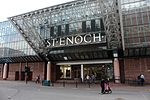South Portland Street Suspension Bridge

The South Portland Street Suspension Bridge is a suspension-type footbridge across the River Clyde in Glasgow, Scotland linking the City Centre on the north side to the Laurieston and Gorbals districts on the south side. The bridge, made from wrought iron with arched sandstone towers at either end, has a suspension span of 414 ft (126 m); the bridge deck is 13 ft (4.0 m) wide. It was built between 1851 and 1853, replacing a temporary wooden bridge on the same site (used from 1832 to 1846) designed by Robert Stevenson. Its structure was modified in 1871 and it has been refurbished on several further occasions, including repair work by Sir William Arrol & Co. in 1926.The bridge is so named due to being the continuation of South Portland Street in Laurieston; however it is perpendicular to the better-known Carlton Place (a well-preserved cobbled street of Georgian terraces dating from the early 1800s) and so is sometimes known as Carlton Place Bridge or simply Glasgow Suspension Bridge although there is another bridge of this type upstream nearby. Both the bridge and the buildings of Carlton Place are category A listed.
Excerpt from the Wikipedia article South Portland Street Suspension Bridge (License: CC BY-SA 3.0, Authors, Images).South Portland Street Suspension Bridge
South Portland Street Suspension Bridge, Glasgow Tradeston
Geographical coordinates (GPS) Address Nearby Places Show on map
Geographical coordinates (GPS)
| Latitude | Longitude |
|---|---|
| N 55.854984 ° | E -4.255561 ° |
Address
South Portland Street Suspension Bridge
South Portland Street Suspension Bridge
G1 4JH Glasgow, Tradeston
Scotland, United Kingdom
Open on Google Maps







